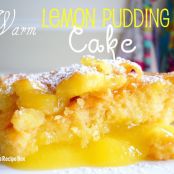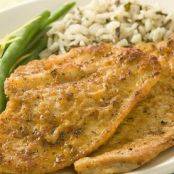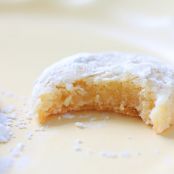Lemon Pudding Cakes From America's Test Kitchen Season 15: Springtime Sweets
By á-44910
WHY THIS RECIPE WORKS:
Despite the ease of a single batter to produce two texturally distinct layers, lemon pudding cake is a very unpredictable undertaking. With an understanding of the underlying processes that cause this characteristic separation, we were able to produce a more flavorful and better-textured version that bakes up correctly time and again.
Ingredients
- INGREDIENTS
- 1 cup whole milk
- 1/2 cup heavy cream
- 3 tablespoons grated lemon zest plus 1/2 cup juice (3 lemons)
- 1 cup (7 ounces) sugar
- 1/4 cup (1 1/4 ounces) all-purpose flour
- 1/2 teaspoon baking powder
- 1/8 teaspoon salt
- 2 large eggs, separated, plus 2 large whites
- 1/2 teaspoon vanilla extract
Details
Preparation
Step 1
INSTRUCTIONS
1. Adjust oven rack to middle position and heat oven to 325 degrees. Bring milk and cream to simmer in medium saucepan over medium-high heat. Remove pan from heat, whisk in lemon zest, cover pan, and let stand for 15 minutes. Meanwhile, fold dish towel in half and place in bottom of large roasting pan. Place six 6-ounce ramekins on top of towel and set aside pan.
2. Strain milk mixture through fine-mesh strainer into bowl, pressing on lemon zest to extract liquid; discard lemon zest. Whisk 3/4 cup sugar, flour, baking powder, and salt in second bowl until combined. Add egg yolks, vanilla, lemon juice, and milk mixture and whisk until combined. (Batter will have consistency of milk.)
3. Using stand mixer fitted with whisk, whip egg whites on medium-low speed until foamy, about 1 minute. Increase speed to medium-high and whip whites to soft, billowy mounds, about 1 minute. Gradually add remaining 1/4 cup sugar and whip until glossy, soft peaks form, 1 to 2 minutes.
4. Whisk one-quarter of whites into batter to lighten. With rubber spatula, gently fold in remaining whites until no clumps or streaks remain. Ladle batter into ramekins (ramekins should be nearly full). Pour enough cold water into pan to come one-third of way up sides of ramekins. Bake until cake is set and pale golden brown and pudding layer registers 172 to 175 degrees at center, 50 to 55 minutes.
5. Remove pan from oven and let ramekins stand in water bath for 10 minutes. Transfer ramekins to wire rack and let cool completely. Serve.
TECHNIQUE
TECHNIQUE: A COLD BATH
Water baths insulate food from the heat of the oven, helping custards and other delicate desserts cook more slowly. Typically, the bath gets filled with boiling water. Because the bottom pudding layer in this dessert cooks more quickly than the cake layer, we found that cold water works better, allowing the pudding to set slowly and without curdling, giving the cake time to bake through.
1. A large roasting pan accommodates more water, which takes longer to heat, providing more protection.
2. Water reaches just one-third of the way up, insulating only the pudding layer. Unaffected by insulation, the slow-to-cook cake layer bakes at a higher temperature.
3. A towel lining the bottom of the pan secures the ramekins.
TECHNIQUE
SCIENCE: MAXIMIZING CITRUS FLAVOR
To produce bold citrus flavor in our pudding without marring its silky-smooth texture with pieces of lemon zest, we steep the zest in liquid (and then strain it out). Some of the flavor compounds in the zest are fat-soluble, such as d-limonene. others, like citric acid, are water soluble. To extract the most flavor, we infuse the zest into a mixture of two liquids that we use in our batter—milk and heavy cream—that together contain goodly amounts of both water and fat.
You'll also love
-
 Lemon Pudding Cake
4.6/5
(59 Votes)
Lemon Pudding Cake
4.6/5
(59 Votes)
-
 Warm Lemon Pudding Cake
4.4/5
(39 Votes)
Warm Lemon Pudding Cake
4.4/5
(39 Votes)
-
 Luby's Cafeteria's Macaroni And...
3.5/5
(6 Votes)
Luby's Cafeteria's Macaroni And...
3.5/5
(6 Votes)
-
 Garlic Dragon Shrimp
3/5
(3 Votes)
Garlic Dragon Shrimp
3/5
(3 Votes)
-
 ALMOND ZUCCHINI CAKE
3/5
(4 Votes)
ALMOND ZUCCHINI CAKE
3/5
(4 Votes)
-
 Philly Cream Cheese Apricot Cookies
3/5
(2 Votes)
Philly Cream Cheese Apricot Cookies
3/5
(2 Votes)
-
 Big Batch Banana Muffins
2.5/5
(2 Votes)
Big Batch Banana Muffins
2.5/5
(2 Votes)
-
 Chocolate Chip Orange Zucchini...
4/5
(2 Votes)
Chocolate Chip Orange Zucchini...
4/5
(2 Votes)



Review this recipe